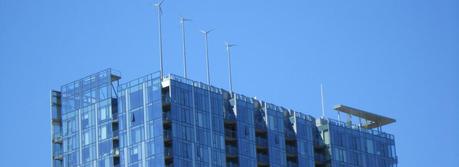 Rooftop wind turbines in Portland, Oregon. (Credit: Flickr @ Neal Jennings http://www.flickr.com/photos/sweetone/)
Rooftop wind turbines in Portland, Oregon. (Credit: Flickr @ Neal Jennings http://www.flickr.com/photos/sweetone/)
Americans are increasingly installing wind turbines near their homes, farms and businesses to generate their own energy, concludes a new report released this week. According to the report, annual wind power capacity additions in the United States achieved record levels in 2012, motivated by the then-planned expiration of federal tax incentives at the end of 2012 and recent improvements in the cost and performance of wind power technology.
Roughly 13.1 gigawatts (GW) of new wind power capacity were connected to the U.S. grid in 2012, well above the previous high in 2009. The prices offered by wind projects to utility purchasers averaged $40/MWh for projects negotiating contracts 2011 and 2012, spurring demand for wind energy. At the same time, even with a short-term extension of federal tax incentives now in place, the wind power industry is facing uncertain times, in part due to low natural gas prices and continued policy uncertainty.
“Wind energy prices—particularly in the central U.S.— now rival the lows set back in 2003,” notes Berkeley Lab Staff Scientist Ryan Wiser. “This is especially notable because technology advancements have allowed wind projects to be built in lower quality wind resource areas.”
“The tremendous growth in the U.S. wind industry over the past few years underscores the importance of consistent policy that ensures America remains a leader in clean energy innovation,” said Energy Secretary Ernest Moniz. “As the fastest growing source of power in the United States, wind is paving the way to a cleaner, more sustainable future that protects our air and water and provides affordable, clean renewable energy to more and more Americans.”
The 2012 Market Report on Wind Technologies in Distributed Applications is also the first comprehensive analysis on a growing field called distributed wind, which involves generating wind energy close to where it will be used instead of purchasing power from large, centralized wind farms. Distributed wind can range from a small, solitary turbine in someone’s backyard to several large turbines that power a manufacturing facility or a neighborhood.
“The public often pictures large wind projects with long rows of turbines when they think of wind power,” said the report’s lead author Alice Orrell, an energy analyst at the Department of Energy’s Pacific Northwest National Laboratory. “But this report provides detailed data that shows this image is incomplete. Many of the nation’s turbines are for distributed, not centralized, wind projects.”
Key findings from the U.S. Department of Energy’s “2012 Wind Technologies Market Report” include:
• Wind is a credible source of new generation in the U.S. Wind power comprised 43% of all new U.S. electric capacity additions in 2012 and represented $25 billion in new investment. Wind power currently contributes more than 12% of total electricity generation in nine states (with three of these states above 20%), and provides more than 4% of total U.S. electricity supply.
• Despite challenges, a growing percentage of the equipment used in U.S. wind power projects has been sourced domestically in recent years. Wind turbine and component manufacturers met the challenge of supplying a 13 GW market in 2012, albeit with growing pains. Seven of the ten wind turbine suppliers with the largest share of the U.S. market in 2012 had one or more operational manufacturing facility in the United States in 2012; in contrast, only eight years earlier, there was only one active utility-scale turbine manufacturer assembling turbines domestically.
• Turbine scaling is boosting wind project performance. Since 1998-99, the average nameplate capacity of wind turbines installed in the U.S. has increased by 170% (to 1.94 MW in 2012), the average turbine hub height has increased by 50% (to 84 meters), and the average rotor diameter has increased by 96% (to 94 meters). This substantial scaling has enabled wind project developers to economically build projects in lower wind-speed sites, and is driving capacity factors higher for projects located in fixed wind resource regimes.
• Falling wind turbine prices are pushing installed project costs lower. Wind turbine prices have fallen 20 to 35% from their highs back in 2008, and these declines are pushing project-level costs down. Based on a large sample of wind projects, average project costs in 2012 were down almost $200/kW from the reported average cost in 2011.
• Wind energy prices have been falling since 2009, and now rival previous lows. After topping out at nearly $70/MWh in 2009, the average levelized long-term price from wind power sales agreements signed in 2011/2012—many of which were for projects built in 2012—fell to around $40/MWh nationwide.
• Looking ahead, projections are for slow growth in 2013, followed by a much stronger year in 2014. Though federal tax incentives are now available for wind projects that initiate construction by the end of 2013, it will take time to recharge the project pipeline. “As a result, 2013 is expected to be a slow year for new capacity additions, lowering not only U.S. but global growth forecasts,” says Mark Bolinger, Research Scientist at Berkeley Lab. “The year 2014, on the other hand, is expected to be a strong year as developers commission projects that began construction in 2013.”
The story above is based on materials provided by Pacific Northwest National Laboratory, the U.S. Department Of Energy and Lawrence Berkeley National Laboratory.

